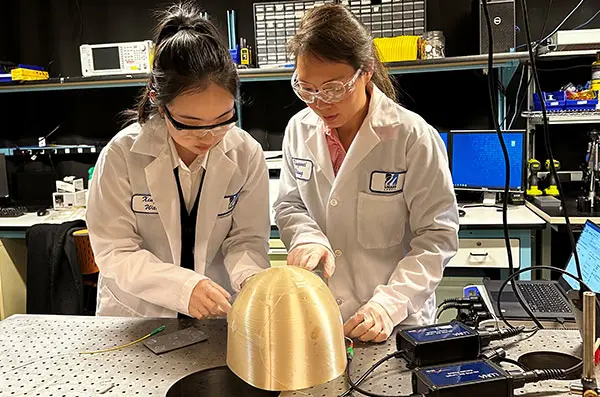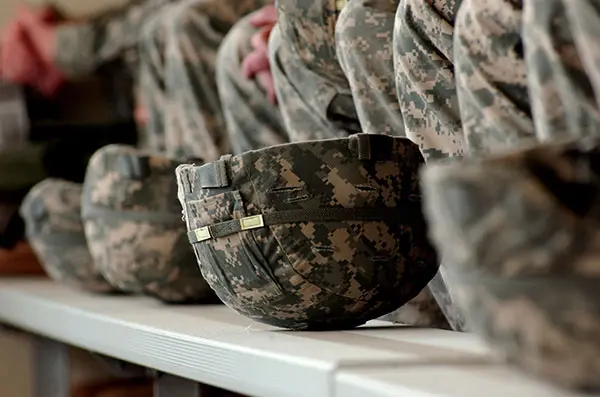Researchers Target Improvements in Manufacturing Process

09/01/2023
By Katharine Webster
Traumatic brain injuries resulting from high-speed impacts and explosions accounted for nearly 30% of serious battlefield injuries in the United States’ two most recent wars in Iraq and Afghanistan, according to military researchers.
So, improving combat helmet design and manufacturing is a priority for the U.S. Army, says Carolyn Westmark, a senior researcher at the Army’s Natick Soldier Systems Center.
“Helmet research will continue forever,” Westmark says.

Right now, a key part of that research is taking place in the lab of Electrical and Computer Engineering Prof. Xingwei Wang, who is developing sensors and software that would allow helmet manufacturers to monitor their processes in real time to prevent structural defects. Wang is working with Westmark and other researchers at the Natick center through UML’s Harnessing Emerging Research Opportunities to Empower Soldiers (HEROES) partnership.
The sensors, consisting of an array of optical fibers that measure pressure and temperature, are designed to be incorporated into thermoprocessing equipment, such as the molds and presses used to form and laminate the different layers of fiberreinforced thermoplastic fabric, Wang says.
“The goal is to design and implement an integrated system that can accurately measure the temperature, strain and pressure distribution during the tooling process, because variations can significantly affect the structural integrity of the helmet and its ability to protect soldiers from bullets, shrapnel and other impacts,” she says.
“The goal is to design and implement an integrated system that can accurately measure the temperatures, strain and pressure distribution during the tooling process.” -Prof. Xingwei Wang
Wang says five of her Ph.D. students have been supported by the four-year HEROES research project, as have three current and former Ph.D. students in the Manning School of Business. Under the guidance of Manning Assoc. Dean Yi Yang, the business students are helping to prepare a patent application and doing research into other potential commercial uses for the sensing system.
Wang says that while her doctoral students do fundamental academic research and publish papers under other grants, the Department of Defense project offers them practical experience that will serve them well in their future careers.
“It’s very different, and we like that. This is more hands-on—solving real problems,” Wang says. “A lab is a very controlled environment. In the field, a lot of unexpected things can happen, and the students are learning how to deal with that.”
In the first two phases of the four-year research grant, Wang and her students designed new sensors made from thin optical fibers to measure pressure and strain on the helmet shell at different stages of manufacturing.
In Phase III, they experimented with optimal layouts for the sensors to gather the information needed and display it on the connected “interrogation” software in real time. The best configuration was an interconnecting circular pattern, using several strands of optical fiber, that closely matches the helmet’s contours, says Ph.D. student Lidan Cao.
In Phase IV, which is now ongoing, the researchers examined different ways to protect the fragile optical fibers from the extreme pressures and high temperatures used in manufacturing helmets.
They came up with two possibilities for the protective substrate of the distributed optical fiber sensor, both of which are in their application for a provisional patent: a thin film and a 3D-printed elastomer. Either one could potentially be used inside an industrial mold, Wang says, and the film could also be embedded in prototype helmets to compare how helmets of different materials and designs are affected by combat conditions.
Westmark and Jason Parker, another researcher at the Natick Soldier Systems Center, have collaborated closely with Wang and her students, supplying specifications and conducting successful field tests on the optical fibers embedded in the substrates, says Ravi Mosurkal, HEROES co-director for the Army. Westmark and Parker have also introduced Wang and her team to defense manufacturers interested in implementing the technology.
Cao, a fourth-year Ph.D. student, says that she has learned a lot from working on a specific industrial problem. She also sees the potential for the technology to improve precision manufacturing processes in other industries, such as the automotive and aerospace sectors.
Optical fiber sensors are “amazing,” she says. “It’s a field that is developing rapidly, and it has a lot of applications.”
